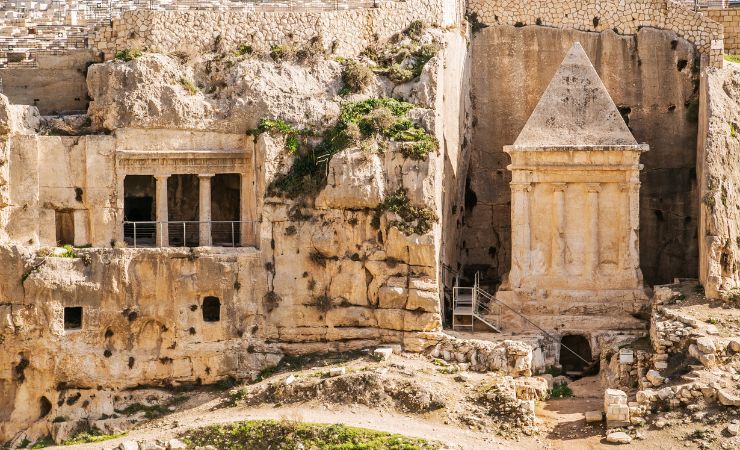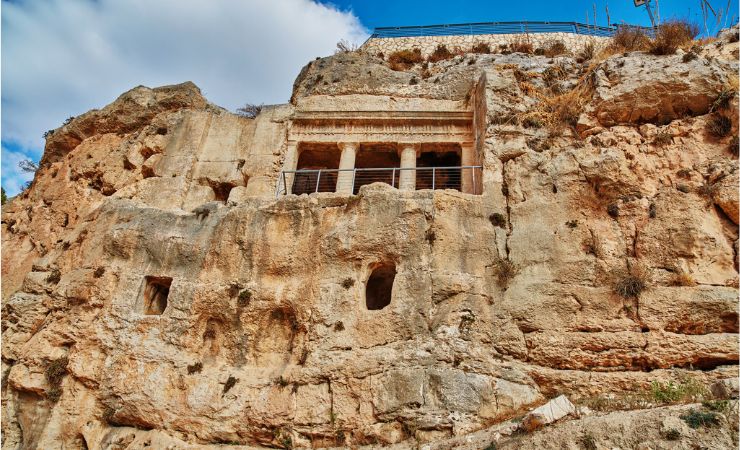Benei Hezir Tomb: A Testament to a Priestly Legacy
Originally published: August 2023 | Last updated: May 2025
The Tomb of Benei Hezir is an ancient burial site, dating back to the Second Temple period that belongs to a priestly family. The Bnei Hazir family had a significant role in the religious and social fabric of ancient Israel.

Location
Situated in the Kidron Valley, the Tomb of Benei Hezir is adjacent to the renowned Tomb of Zechariah and a stone’s throw away from the Tomb of Absalom. This location, with its proximity to the Temple Mount, underscores the family’s prominence in Jerusalem’s ancient society.
Biblical context
The name Hezir in the Bible
The name Hezir appears twice in the Bible. In the Hebrew Bible, one Hezir was the founder of the 17th priestly division as mentioned in 1 Chronicles 24:15 (“The seventeenth to Hezir, the eighteenth to Happizzez”). Another Hezir was among the leaders who sealed the covenant with Nehemiah, as noted in Nehemiah 10:20.
Who were the Benei Hezir?
The Benei Hezir family, as the inscriptions on the tomb reveal, spanned several generations. The tomb’s grandeur and its location in the Kidron Valley suggest that this was a wealthy family, possibly of high social standing. The Hebrew inscription on the tomb indicates that this was the burial site of a priestly family called Benei Hezir, which translates to “sons [descendants] of Hezir.” The family’s significance is further highlighted by their association with the Second Temple, a pivotal religious institution of the time.



Priestly Divisions in Ancient Israel
The priestly divisions, also known as sacerdotal courses, refer to the groups into which Jewish priests were divided for their service in the Temple in Jerusalem. These divisions are detailed in the Biblical Book of Chronicles 24.
Origin and Role in the Temple: The Book of Chronicles describes these priests as “descendants of Aaron.” Aaron, the brother of Moses, had four sons: Nadab, Abihu, Eleazar, and Ithamar. However, Nadab and Abihu died before Aaron, leaving only Eleazar and Ithamar with descendants. King David designated one priest from Eleazar’s descendants (Zadok) and another from Ithamar’s (Ahimelech) to establish the priestly work groups. Sixteen of Eleazar’s descendants were chosen to lead priestly orders, while only eight from Ithamar’s line were chosen. This was due to the greater number of leaders among Eleazar’s descendants.
Division and Service: The 24-family division was an expansion of a previous division by Moses into 8 (or 16) divisions. Lots were drawn to determine the order of Temple service for these priestly orders. Each order was responsible for ministering during a different week and Shabbat in the Temple in Jerusalem.
- The shifts were calculated for that each division served a minimum of two weeks a year, one week at a time. All orders were present during biblical festivals. Their duties included offering daily and holiday Temple sacrifices and administering the Priestly Blessing to the people.
- Post-Temple Destruction: After the Temple’s destruction at the end of the First Jewish Revolt at 70AD, Jewish tradition records that descendants of each priestly watch established separate residences in the Galilee. They maintained this pattern for several centuries, anticipating the Temple’s reconstruction and the reinstatement of the priestly courses.

Architecture of the Tomb of Benei Hezir
The Tomb of Benei Hezir, is the oldest of the monumental rock-cut tombs in the Kidron Valley. It is adjacent to the Tomb of Zechariah and near the Tomb of Absalom. Dating back to the Second Temple period, it is a complex of burial caves.
- Design and Layout: The tomb of Benei Hezir was initially accessed via a single rock-cut stairwell descending from the north. Later, an additional entrance was created by quarrying a tunnel from the courtyard of the “Tomb of Zechariah,” which is also the current entrance.
Architectural Features: The façade of the tomb showcases a classical distyle in antis, with two pillars between two pilasters. Above these is an undecorated architrave with an engraved Hebrew inscription. The tomb’s architectural style is influenced by ancient Greek architecture, evident in the two pillars with Doric capitals. There’s also a Nabataean influence in its architecture and decorative elements.
- The inscription: The inscription on the Tomb of Benei Hezir reads “This is the grave and the soul of Eliezer Hanya Yoazar Yehuda Shimon Yochanan Benei (sons of) Yosef Beb (son of) Oved, Yosef and Elazar Benei (sons of) Hania, kohanim (priests) of the Hezir family.” The inscription mentions a soul (nefesh) which usually refers to a beautiful monumental structure alongside the grave or tomb. Some believe that the Tomb of Zachariah that dates from the same period is the the soul (or nefesh) of the Bnei Hezir tombs. A different proposal was made that the Soul is a façade that did not survive to the north of the Doric dystilos-in-antis was the original nefesh. It is easy to imagine that the upper part of the facade is could have been a Nabataean tower similar to those found in Petra.
- Historical Context: The tomb dates back to the second century BCE, during the Hellenistic period and the Hasmonean monarchy era.
Additional Information
- Biblical Period: Division of priests into 24 shifts/divisions is established, based on the descendants of Aaron’s sons, Eleazar and Ithamar. This division and the order of shifts are recorded in front of King David and other dignitaries. The family of Hezir is listed as the seventeenth priestly division.
- 2nd Century BCE (specifically the second half): The Benei Hezir tomb in the Kidron Valley is carved. Its architectural style is Doric, reflecting the Hellenistic period and the Hasmonean monarchy era. This tomb is initially accessed via a rock-cut stairwell from the north. For approximately 100 years, the Benei Hezir tomb is the only tomb in front of the Temple Mount, indicating the family’s high status.
- Second Temple Period (from the Hasmonean period until 70 CE): The Benei Hezir family continues to use their tomb. The inscription on the tomb reveals its use across multiple generations of the priestly family.
- Later Period (after the initial carving of the tomb): An additional entrance to the Benei Hezir tomb is created by quarrying a tunnel from the courtyard of the monument known as the Tomb of Zechariah.
- 1837?: Augustine Aubert creates a drawing highlighting the Benei Hezir tomb, with the Tomb of Zechariah and Tomb of Absalom nearby.
- 1864: The inscription on the Benei Hezir tomb is first made known to scientific research by French researcher de Saulcy.
- 19th Century: Westerners still identify the Benei Hezir tomb monument with the tomb of St. James the Apostle. According to tradition, James hid in the tomb from the Romans and was buried there in 62 CE.
Sources and additional reading
Nearby Sites
Tomb of Absalom: An iconic ancient monument in the Kidron Valley, traditionally ascribed to Absalom, the rebellious son of King David. Its unique design combines a conical roof atop a square structure.
Tomb of the Virgin Mary: Located at the foot of Mount of Olives in the Kidron Valley, it’s a revered Christian site believed by many to be the burial place of Mary, the mother of Jesus.
Kidron Valley: A significant biblical site, this valley separates the Temple Mount from the Mount of Olives in Jerusalem. It has been a burial place since ancient times, housing numerous historic tombs.
The Church of All Nations: Also known as the Basilica of the Agony, this church, built by architect Antonio Barluzzi, is situated next to the Garden of Gethsemane. It commemorates the spot where Jesus is believed to have prayed before his arrest.



